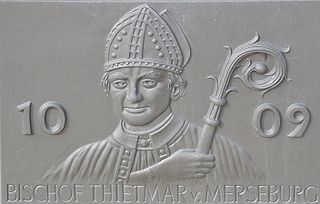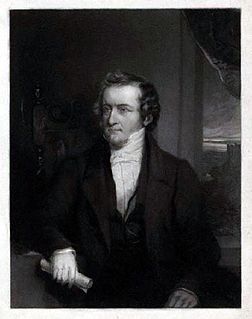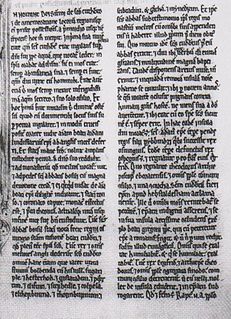Symeonof Durham was an English chronicler and a monk of Durham Priory.

Eadmer or Edmer was an English historian, theologian, and ecclesiastic. He is known for being a contemporary biographer of his archbishop and companion, Saint Anselm, in his Vita Anselmi, and for his Historia novorum in Anglia, which presents the public face of Anselm. Eadmer's history is written to support the primacy of Canterbury over York, a central concern for Anselm.

Richard de Bury, also known as Richard Aungerville or Aungervyle, was an English priest, teacher, bishop, writer, and bibliophile. He was a patron of learning and one of the first English collectors of books. He is chiefly remembered for his Philobiblon, written to inculcate in the clergy the pursuit of learning and the love of books. The Philobiblon is considered one of the earliest books to discuss librarianship in-depth.

Thietmar, Prince-Bishop of Merseburg from 1009 until his death, was an important chronicler recording the reigns of German kings and Holy Roman Emperors of the Ottonian (Saxon) dynasty. Two of Thietmar's great-grandfathers, both referred to as Liuthar, were the Saxon nobles Lothar II, Count of Stade, and Lothar I, Count of Walbeck. They were both killed fighting the Slavs at the Battle of Lenzen.

Acca of Hexham was a Northumbrian saint and Bishop of Hexham from 709 until 732.
Robert Surtees was a celebrated English historian and antiquary of his native County Durham.
The Durham Rite is a historical fusion of the Roman Rite and the Gallican Rite in the English bishopric of Durham.

Coldingham Priory was a house of Benedictine monks. It lies on the south-east coast of Scotland, in the village of Coldingham, Berwickshire. Coldingham Priory was founded in the reign of David I of Scotland, although his older brother and predecessor King Edgar of Scotland had granted the land of Coldingham to the Church of Durham in 1098, and a church was constructed by him and presented in 1100. The first prior of Coldingham is on record by the year 1147, although it is likely that the foundation was much earlier. The earlier monastery at Coldingham was founded by St Æbbe sometime c. AD 640. Although the monastery was largely destroyed by Oliver Cromwell in 1650, some remains of the priory exist, the choir of which forms the present parish church of Coldingham and is serviced by the Church of Scotland.
The Prior of Coldingham was the head of the Benedictine monastic community of Coldingham Priory in Berwickshire. Coldingham Priory was founded in the reign of David I of Scotland, although his older brother and predecessor King Edgar of Scotland had granted the land of Coldingham to the Church of Durham in 1098, and a church was constructed by him and presented in 1100 AD. The first prior is on record by the year 1147, although an earlier foundation is almost certain. The monastic cell was a dependent of Durham until the 1370s, and in 1378 King Robert II of Scotland expelled the Durham monks; for the following century the cell had two priors, one chosen by Durham and one chosen by the Scots. It became a dependent of Dunfermline Abbey. It was subject to increasingly secular control from the late 15th century into the 16th century. The following is a list of priors and commendators:

The Libellus de exordio atque procursu istius, hoc est Dunhelmensis, ecclesie, in short Libellus de exordio, is a historical work of marked literary character composed and compiled in the early 12th-century and traditionally attributed to Symeon of Durham. It relates the history of bishopric and church of Durham and its predecessors at Lindisfarne and Chester-le-Street (Cunecacestre). It is sometimes also known as the Historia Dunelmensis ecclesiae.
The Historia Regum is a historical compilation attributed to Symeon of Durham, which presents material going from the death of Bede until 1129. It survives only in one manuscript compiled in Yorkshire in the mid-to-late 12th century, though the material is earlier. It is an often-used source for medieval English and Northumbrian history. The first five sections are now attributed to Byrhtferth of Ramsey..
The Durham Liber Vitae is a confraternity book produced in north-eastern England in the Middle Ages. It records the names of visitors to the church of the bishopric of Durham, and its predecessor sees at Lindisfarne and Chester-le-Street. In England, it is the oldest book of this type, although it is paralleled by later English confraternity books, most notably the New Minster Liber Vitae.
De Iniusta Vexacione Willelmi Episcopi Primi is a late 11th-century historical work detailing the trial of William de St-Calais, a medieval Norman Bishop of Durham from 1081 to 1096. It is the first surviving detailed account of an English trial before the king, and as such is an important source for historians.
The Surtees Society is a text publication society and registered charity based in Durham in northern England. The society was established on 27 May 1834 by James Raine, following the death of the renowned County Durham antiquarian Robert Surtees. Raine and other former friends of Surtees created the society to honour his memory and carry on his legacy, with the focus on publishing documents relating to the region between the River Humber and Firth of Forth in the east and the River Mersey and the River Clyde in the west, the region that had once constituted the kingdom of Northumbria. Membership of the Society is by annual subscription. Members receive the book published for the year of subscription.

James Raine (1791–1858) was an English antiquarian and topographer. A Church of England clergyman from the 1810s, he held a variety of positions, including librarian to the dean and chapter of Durham and rector of Meldon in Northumberland.

The Historia de Sancto Cuthberto is a historical compilation finished some time after 1031. It is an account of the history of the bishopric of St Cuthbert—based successively at Lindisfarne, Norham, Chester-le-Street and finally Durham—from the life of St Cuthbert himself onwards. The latest event documented is a grant by King Cnut, c. 1031. The work is a cartulary chronicle recording grants and losses of property as well as miracles of retribution, under a loose narrative of temporal progression. The text survives in three manuscripts, the earliest of which dates from around 1100. The original version of the text is not thought to be extant; rather, all surviving manuscripts are thought to be copies of an earlier but lost exemplar. The Historia is one of the sources for the histories produced at Durham in the early 12th century, particularly the Historia Regum and Symeon of Durham's Libellus de Exordio.

Lawrence of Durham was a 12th-century English prelate, Latin poet and hagiographer. Born in southern England, at Waltham in Essex, Lawrence was given a religious education, and excelled at singing and poetry composition. In his youth Lawrence joined Durham Cathedral Priory and became a Benedictine monk. In the 1130s Lawrence became a courtier of Geoffrey Rufus, bishop of Durham.
Denis Granville was an English non-juring cleric, Dean of Durham and then Jacobite exile.
Geoffrey of Coldingham was a late 12th and early 13th-century monk and chronicler.
Nicholas was a twelfth-century Bishop-elect of the Isles. There is no evidence that he was ever consecrated.








